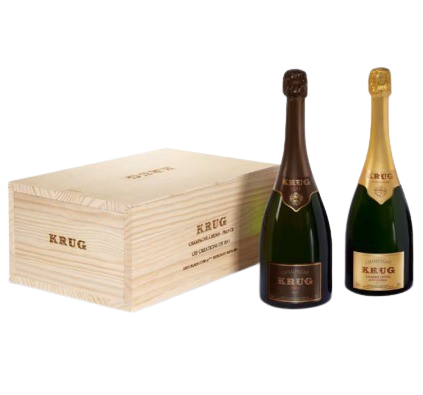2011 Krug: 95 Punkte
The 2011 Krug is a singular, distinctive vintage at this address. Revealing aromas of lemon, confit citrus, dried herbs, hazelnuts, pear and ripe orchard fruits mingled with spices, it's medium to full-bodied, round and dense, with a phenolic, singular entry and a structured, almost tannic but elegant mid-palate framed by a fleshy core of fruit. It has a pinpoint mousse and a long, mineral and saline finish enhanced by a lot of chalky dry extracts. Compared to previous vintages, which were tauter and more incisive, this rendition is more austere, aging gracefully into a Champagne of understated elegance and revealed austerity. When I met Julie Cavil, Krug’s Chef de Caves, in July, the extensive construction at Joseph—the name the house has given to the new winery in the heart of Ambonnay—was nearing completion. During the visit, I had the opportunity to taste the latest rendition of the cuvée, the 172ème Edition, based on the 2016 vintage, alongside some of the oldest cuvées and the newly released Clos d’Ambonnay from the 2008 vintage. - Yohan Castaing (10/2024)
NV Krug Grande Cuvée 167ème Edition: 95+ Punkte
Making its debut this year is Krug's NV Grande Cuvée 167ème Édition, a beautiful wine that wafts from the glass with aromas of yellow orchard fruit, peach and waxy citrus rind, complemented by complex notes of freshly baked bread, walnuts and smoke. On the palate, the wine is full-bodied and muscular but incisive, with a deep and concentrated core, a pinpoint mousse and a long, complex finish. Built around the 2011 vintage, the wine includes reserve wines dating back to 1995 and was disgorged in the winter of 2017-2018. Readers are advised to give it at least a couple years of bottle age before popping corks. A flying April visit to Reims enabled me to taste this exciting selection of recent and forthcoming releases from Krug, including the latest rendition of their iconic Grande Cuvée—a bottling that's now enumerated to offer wine lovers a clearer idea of what they're buying and when they might want to drink it—and the 2006 vintage. As readers will know, the concept behind Grande Cuvée is to draw on the maison's unrivaled library of reserve wines to complement the base yielded by each successive vintage, supplementing any deficiencies and tempering any excesses. Thus, a rich vintage such as 2006 will be blended with brighter, livelier reserve wines, whereas a leaner, tangier year will be enriched with reserve wines from broader, fleshier years. Of course, that's a simplification, and the devil is in the detail: each "Édition" of Grande Cuvée typically contains considerably more than 100 different wines and is the result of six months of intensive tasting by the Krug team. The aim, as Cellar Master Eric Lebel describes it, is not to produce the same wine each year, but to produce the best possible wine each year, so every rendition of Grande Cuvée is different—differences that are now highlighted by Krug's laudable decision to enumerate each successive release. A lengthier visit shortly after this issue goes to press will delve deeper into the secrets of the maison that many—the present writer included—would denominate as Champagne's greatest house, but for now, all the wines reviewed here evidently come warmly recommended, and they are striking testimony to Krug's remarkable consistency. - William Kelley (04/2019)







